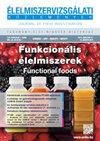在烘焙工业中使用酿酒商的废谷物作为酿造工业的副产品
Q4 Agricultural and Biological Sciences
引用次数: 3
摘要
食品工业副产品的利用是当今重要的环境和经济任务之一。在食品生产过程中形成的副产物通常用于饲料目的,但在许多情况下,这些材料也可以用于人类食品的生产。啤酒酿造者酿造啤酒后留下的废谷物是一种具有良好营养参数的副产品,具有低糖、高纤维和高蛋白质含量。我们实验的主要目标是将啤酒厂的废谷物重新引入食品行业,重点是创新和可持续发展,将其用于匈牙利食品法典制定和监管的商业烘焙产品(咸味奖章/晶圆)。Brewer的废谷物由植物蛋白和纤维(非活性麦芽)组成,这可能会在制备烘焙产品时改善成分特性。在我们的研究过程中,我们制备了富含啤酒糟的奖章,其中应强调其高膳食纤维含量的有益参数,这有助于实现消费者的健康意识饮食。富含膳食纤维的饮食,加上适量的运动,可以降低患某些疾病(如癌症和心血管疾病)的风险。本文章由计算机程序翻译,如有差异,请以英文原文为准。
Using brewer’s spent grain as a byproduct of the brewing industry in the bakery industry
The utilization of food industry byproducts is one of today’s important environmental and economic tasks. Byproducts that form during food production are typically used for feed purposes, but in many cases these materials can also be used in the production of human foods. The brewer’s spent grain left behind after brewing beer is a byproduct with favorable nutrition parameters, with low sugar and high fiber and protein contents. The main objective of our experiments was the reintroduction of brewer’s spent grain into the food industry, with a focus on innovation and sustainable development, by utilizing it in commercially available bakery products (salty medallions / wafers) formulated and regulated in the Hungarian Food Codex. Brewer’s spent grain consists of vegetable proteins and fibers (inactive malt), which may improve the compositional characteristics when preparing bakery products. In the course of our research, medallions enriched with brewer’s spent grain were prepared, of the beneficial parameters of which its high dietary fiber content should be highlighted, which can contribute to the realization of a health-conscious diet for consumers. A diet rich in dietary fiber, combined with an adequate amount of exercise, can reduce the risk of developing certain diseases (e.g., cancer and cardiovascular diseases).
求助全文
通过发布文献求助,成功后即可免费获取论文全文。
去求助
来源期刊

Elelmiszervizsgalati Kozlemenyek
Agricultural and Biological Sciences-Food Science
CiteScore
0.20
自引率
0.00%
发文量
10
期刊介绍:
The main topics, which we are waiting to issue in our paper, are the next:
Chemical food and feed analysis (ingredients, macro-, mezo- and micro components, harmful pollutants, processing by-products etc.);
General food and feed chemistry related to several food and feed processing technologies;
Food and feed toxicology;
Relation between the agro technology and the food chain safety;
Microbiological food and feed analysis (pathogens, spoilage bacteria, general food/feed microbiology, microorganisms of several processing technologies etc.);
Rapid food and feed test methods (“classical” and instrumental technologies);
Molecular biological food and feed analysis (GMOs, GMO analysis etc.)
Effects of genetically modified organisms on the entire food chain and the environment;
Sensorial food and feed analysis;
Investigation of non-food products (mainly several disinfectants, production aids);
Investigation of food contact materials (migration tests, residual investigations, etc.);
Legislation topics, regulation of the whole food chain on the territory of food and feed processing, retailing, distribution (European, Hungarian, other countries);
Standardisation news and comments on the topics of whole food chain;
Other topics, results of investigations etc. (the Editorial Board keeps the right to measure the manuscripts arriving to the Editorial Office according to the principles of the journal).
 求助内容:
求助内容: 应助结果提醒方式:
应助结果提醒方式:


